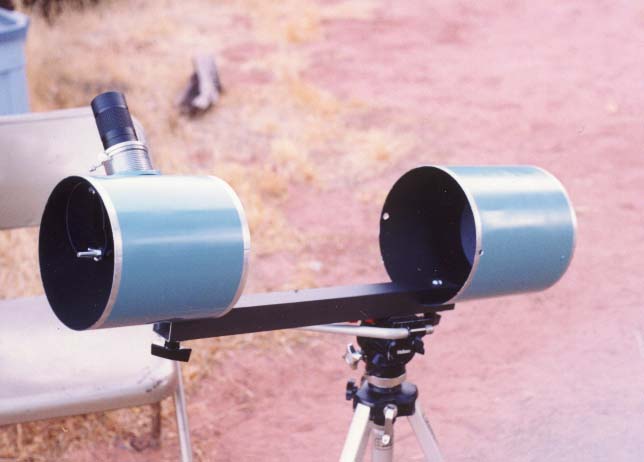|
|
|
This scope started with an idea presented to me by Todd Gross www.weatherman.com who was looking for a compact travel scope with perhaps a bit more aperture than is available with airline portable refractors. Similar to the CT-100 built by Coulter several years ago, this scope ended up not much larger but with the light gathering advantage a 6" mirror offers. Todd made a prototype and we refined the design as progress was made to make it reasonably compact and sturdy. Unfortunately I did not do a series of construction photos so I'll describe a few of the details that aren't apparent in the photos.

The upper tube is 7" diameter aluminum while the mirror and cell are housed in an 8" diameter section. The mirror and cell attach with three collimation bolts to a snugly fitting plywood disk in the bottom of the 8" tube. Care was taken to inset the collimating wing nuts so the tube could sit flat on a surface. The plywood disk has a 1/8" groove routed with a 7" diameter circling the mirror. This allows the upper tube to slip inside the lower assembly and nest tightly for transport. A close look at the focuser shows the low profile base is welded to the tube and the 2" focus tube can be unscrewed and attached from the inside for travel.
Everything is sized to provide clearance between all the components when packed away. I can't recall how we established securing the focuser and lock screw in the travel position. The last piece (not shown) is a plywood disk with another groove that slips into the top of the 8" tube and completes the nesting procedure. A couple of thumb screws thread into inserts in the disk through the holes seen in the 8" tube and secure everything for transit. A final touch included a drawer handle for carrying installed on the outside of the top plywood disk.
The strut is 1.5" thin wall square aluminum tubing with slits cut approximately 2 to 3" deep on each end. The tube sections, with an alignment slot cut for clearance around the clamp bolts, slide into these slits and are clamped in place for use. The strut is left attached to the tripod for transit as this seemed a simpler solution compared to using multiple sections or trusses. With a good quality tripod, the scope is fairly stable and I did final testing on Mars using 320x with a good amount of detail visible. The mirror is an f/5 as I was more comfortable providing this quality than at a shorter f/ratio that could make for a more compact strut length.